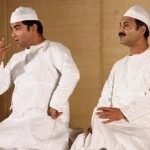 Dastangoi, a sixteenth century lost art form of storytelling in Urdu, was part of a cultural event organized by the Aga Khan Trust for Culture in the recently renewed monument “Chaunsath Khamba”, Nizamuddin on 10-11 December 2010. The entire event was organized by the Trust with the aim of re-introducing the historic monuments and rich cultural heritage of the area to the city.
Dastangoi, a sixteenth century lost art form of storytelling in Urdu, was part of a cultural event organized by the Aga Khan Trust for Culture in the recently renewed monument “Chaunsath Khamba”, Nizamuddin on 10-11 December 2010. The entire event was organized by the Trust with the aim of re-introducing the historic monuments and rich cultural heritage of the area to the city.
Dastangoi derives its name from the Persian words for epic (Dastan) and telling (goi). Dastans were stories which were always passed on and communicated orally. The stories entertained audiences with tales of war, magic, deception, adventure etc. ‘Dastangoi’ performances can include either traditional tales created by ‘dastangos’ or contemporary stories. The performers, Dastangos, were mimics, narrators, actors who used to recreate and mould stories spontaneously while performing.
Mahmood Farooqui, a Delhi based historian, revived Dastangoi under the guidance of the leading scholar of the Dastanic tradition, S. R. Faruqi. He collaborates with Danish Husain in his venture of reviving Dastangoi as an art form.
On 11th December there were two performances by the Dastangos. The first one was Dastaan-e-Amir Hamza, adapted from the 18th century epic Tilism-e-Hoshruba, which the celebrates life and adventures of Amir Hamza, purportedly an uncle of Prophet Mohammad. The second was a performance on the partition of India depicting the trauma faced by the people. The Dastangos were attired in traditional milk-white kurtas, and employing minimal props, they transported their audience back in time to an enchanting illusory world with their jugalbandi format narration.
Although the entire performance was in pure Urdu, this new form of art kept us completely transfixed for the entire two hours.
For more information including videos of recent Dastangoi performances across the country et al, click here to go to the Dastangoi blog.
Debashree Banerjee
Arundhati Dasgupta
Shrabani Dasgupta
Dastangoi
Dastangoi, a sixteenth century lost art form of storytelling in Urdu, was part of a cultural event organized by the Aga Khan Trust for Culture in the recently renewed monument “Chaunsath Khamba”, Nizamuddin on 10-11 December 2010. The entire event was organized by the Trust with the aim of re-introducing the historic monuments and rich cultural heritage of the area to the city.
Dastangoi derives its name from the Persian words for epic (Dastan) and telling (goi). Dastans were stories which were always passed on and communicated orally. The stories entertained audiences with tales of war, magic, deception, adventure etc. ‘Dastangoi’ performances can include either traditional tales created by ‘dastangos’ or contemporary stories. The performers, Dastangos, were mimics, narrators, actors who used to recreate and mould stories spontaneously while performing.
Mahmood Farooqui, a Delhi based historian, revived Dastangoi under the guidance of the leading scholar of the Dastanic tradition, S. R. Faruqi. He collaborates with Danish Husain in his venture of reviving Dastangoi as an art form.
On 11th December there were two performances by
Dastangoi
Dastangoi, a sixteenth century lost art form of storytelling in Urdu, was part of a cultural event organized by the Aga Khan Trust for Culture in the recently renewed monument “Chaunsath Khamba”, Nizamuddin on 10-11 December 2010. The entire event was organized by the Trust with the aim of re-introducing the historic monuments and rich cultural heritage of the area to the city.
Dastangoi derives its name from the Persian words for epic (Dastan) and telling (goi). Dastans were stories which were always passed on and communicated orally. The stories entertained audiences with tales of war, magic, deception, adventure etc. ‘Dastangoi’ performances can include either traditional tales created by ‘dastangos’ or contemporary stories. The performers, Dastangos, were mimics, narrators, actors who used to recreate and mould stories spontaneously while performing.
Mahmood Farooqui, a Delhi based historian, revived Dastangoi under the guidance of the leading scholar of the Dastanic tradition, S. R. Faruqi. He collaborates with Danish Husain in his venture of reviving Dastangoi as an art form.
On 11th December there were two performances by the Dastangos. The first one was Dastaan-e-Amir Hamza, adapted from the 18th century epic Tilism-e-Hoshruba, which the celebrates life and adventures of Amir Hamza, purportedly an uncle of Prophet Mohammad. The second was a performance on the partition of India depicting the trauma faced by the people. The Dastangos were attired in traditional milk-white kurtas, and employing minimal props, they transported their audience back in time to an enchanting illusory world with their jugalbandi format narration.
Although the entire performance was in pure Urdu, this new form of art kept us completely transfixed for the entire two hours.
Debashree Banerjee
Arundhati Dasgupta
Shrabani Dasgupta
the Dastangos. The first one was Dastaan-e-Amir Hamza, adapted from the 18th century epic Tilism-e-Hoshruba, which the celebrates life and adventures of Amir Hamza, purportedly an uncle of Prophet Mohammad. The second was a performance on the partition of India depicting the trauma faced by the people. The Dastangos were attired in traditional milk-white kurtas, and employing minimal props, they transported their audience back in time to an enchanting illusory world with their jugalbandi format narration.
Although the entire performance was in pure Urdu, this new form of art kept us completely transfixed for the entire two hours.
Debashree Banerjee
Arundhati Dasgupta
Shrabani Dasgupta
